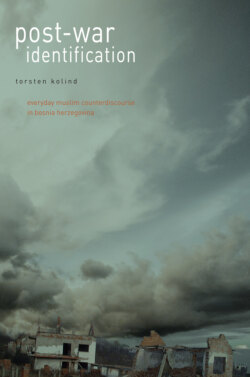Читать книгу Post-War Identification - Torsten Kolind - Страница 8
На сайте Литреса книга снята с продажи.
The return
ОглавлениеAs mentioned above, Stolac participated in a UN-sponsored pilot project to facilitate the inter-federation return of displaced persons. But such returns were difficult to realise, and many local politicians obstructed them. And the situation was particularly grave in Stolac. One must remember that the expulsion of the Muslims from villages in Herzegovina had formed part of a general Croatian war aim of creating ethnically clean territories, whereas return projects such as the one in Stolac attempted to remix these territories. In the eyes of many nationalist-minded Herzegovinian Croats, towns like Stolac had been conquered in war – so they and their contents were to be seen as booty.
In 1996, groups of Muslims began visiting Stolac for the first time since the war. They drove from Mostar by bus escorted by SFOR (Stabilisation Force; a NATO-led multinational force overseeing the implementation of the Dayton agreement). On their arrival in Stolac they were often met by angry Croats throwing stones, eggs and bread at the buses. According to my informants, the throwing of bread was an attempt to insult the Muslims, which alluded to the period during the war when the Muslims were starving to death. The Muslims could not walk the streets or visit their properties, and only some were able to visit relatives’ graves. The visit was a shock for the Muslims. They had not seen the town after the destruction of all Muslim architecture; furthermore, the Croats had not cleaned up the town, and so rubble and garbage marred the face of the town. After the first visits many Muslims were disillusioned. Though they had initially looked forward to returning, many now had second thoughts. Nevertheless, workers protected by SFOR started rebuilding damaged and looted houses, preparing for the first Muslims to return. When the Croats realised that the Muslims were actually going to return, a wave of post-war violence started. Around 200 Muslim houses in the municipality were blown up or burned within a short time, and the work of the pilot project was sabotaged. Though the mayor of the town had instructions from the UN to support the return, and though the police force was officially neutral, not one of the Croats guilty of these crimes was ever caught. The Croats kept intimidating the Muslims hoping that they would not return and reclaim their property, and several episodes of physical violence were recorded.
Despite the difficulties and with a great deal of delay, the first sixteen Muslim families returned to live in Stolac in June 1997. The initial period was very difficult and horrifying. The Muslims did not dare walk the streets in the centre of town, as they were met with threats, comments and sometimes even direct assaults. The social network did not work; mostly people stayed indoors by themselves watching TV. There were no Muslim shops or cafés and nearly all the facilities (institutional as well as others) were controlled by and more or less reserved for Croats only. Many of the returning Muslims felt that Stolac was as a totally new town. The street names were new, the physical shape of the town was new, and there were new and unfamiliar neighbours. The situation was not unequivocally depressing. Croat shops soon started selling the products desired by the Muslims, and one of the Croat-run cafés welcomed the Muslims. People felt that some Croats (mainly old friends) were pleased with their return to Stolac. Slowly things started to improve: more Muslims returned, some Muslims opened shops, and people began to feel safer – though the violent episodes and mining of property did continue and the police’s detection rate was almost zero.
At the beginning of 2000, things improved further. Following the death of the Croatian president Franjo Tuđman in December 1999, the financial support from Croatia to the Herzegovinian Croats and their self-proclaimed independent state Herceg-Bosna dried up (Grandits 2007). This made them much more dependent on funding from the international community, funding that the OHR and UN could use as a political means of exerting pressure. And because Mostar was much more important for the leading Croat politicians in the HDZ than Stolac – which on the other hand held a high symbolic significance for the OHR – deals about such issues as the school and the return of Muslim property could be made. Furthermore, in April 1998, the Croat mayor of Stolac, Pero Raguz, became the first Bosnian politician to be sacked by the UN’s High Representative Carlos Westendorp. And in November 1999 his successor Pero Pazin was also sacked, due to his own obstruction of the return of the Muslim refugees. Furthermore, the local police were placed under the close scrutiny of the international Police Task Force (IPTF). When I started fieldwork in September 2000, the situation for the Muslims in Stolac was thus markedly better than it had been only one or two years before. Despite the improvement of the situation and despite the feeling of the Muslims that the Croats had accepted their presence, at least on a pragmatic level, changes were slow. Stolac was still a more or less totally ethnically divided town, with the Muslims being discriminated against on all levels of society. Many of my informants compared the situation to a kind of apartheid.
